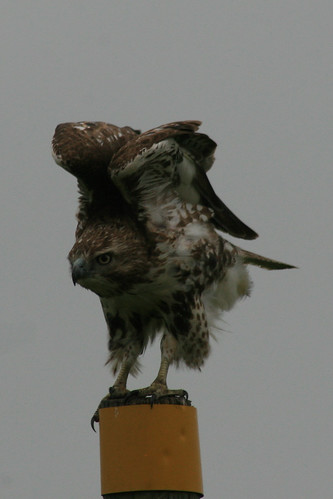tags: Red-tailed Hawk, Buteo jamaicensis, birds, Image of the Day
A very photogenic red-tailed hawk. North Dakota has become something of a haven for raptors. I never saw a bald eagle until seven years ago. Now they are so common that seeing one isn't worth mentioning. Hawks like this one and the previous photo (yesterday) are as common as mile markers.
- Log in to post comments
More like this
tags: birds, Red-tailed hawk, Buteo jamaicensis, ornithology, Image of the Day
Red-tailed hawk, Buteo jamaicensis, in Central Park,
with blood on its talons.
Image: Bob Levy, author of Club George. [larger view].
Bob Levy writes;
I have two comments and images to add to my story of March 10,…
tags: birds, Red-tailed hawk, Buteo jamaicensis, ornithology, Image of the Day
Red-tailed hawk, Buteo jamaicensis, in Central Park,
being taunted by an Eastern grey squirrel.
Image: Bob Levy, author of Club George. [larger size].
Bob Levy writes;
I have two comments and images to add to my…
tags: Pale Male, red-tailed hawk, Buteo jamaicensis, birds, NYC, Central Park, Image of the Day
Pale Male, a pale-morph red-tailed hawk, Buteo jamaicensis, a few seasons ago as he appeared in the book, Club George.
Image: Bob Levy, author of Club George. [larger size].
I don't have a photo to…
tags: birds, Red-tailed hawk, Buteo jamaicensis, ornithology, Image of the Day
Red-tailed hawk, Buteo jamaicensis, in Central Park.
Image: Bob Levy, author of Club George. [larger size].
The photographer writes: The plaintive hawk-alarm call of a Gray Squirrel alerted me that a raptor was in…


Funny you should mention mile markers and red-tailed hawks. Several years ago I was working (briefly) at a Texas state mental health facility 45 miles from my home. I became mightily bored while in the back seat during a car pool ride through bleak farm land, so I started counting red-tailed hawks perched on power lines, fence posts, etc. In those 45 miles I counted 53 red tailed hawks. At about the count of 25 my fellow car poolers got into the act by chanting 'Hawk', 'Hawk',... What was a typically mundane winter day turned into a day of moderate excitement. What a majestic bird!
Do you eat turkey on Thanksgiving being a bird person?
Title: Coronary artery rupture in male commercial turkeys.
Author: Shivaprasad, H.L.
Crespo, R.
Puschner, B.
Found In: Avian pathology. 2004 Apr., v. 33, no. 2
p. 226-232.
ISSN 0307-9457
Abstract: Mortalities of 3% in a 1-week period and 2.5% in a 4-week period occurred in two flocks of 13-week-old to 16-week-old male turkeys, respectively. Eleven of 18 birds submitted to the laboratory for necropsy had large amounts of clotted blood in the pericardial sac and transverse bands of haemorrhage at the base of the left heart. Three other birds had clotted blood in the abdominal cavity due to rupture of the aorta. Histopathology of the hearts with haemorrhage at the base of the left heart revealed medial degeneration, necrosis and rupture of the coronary arteries. Special stains revealed decrease in elastic fibres and increase in fibrous connective tissue in the coronary arteries. Fourteen of 16 birds had a low copper concentration (<5 mg/kg wet weight) in the liver; the zinc concentration was high in one bird. Levels of heavy metals including copper and selenium in the feed were within normal ranges for poultry. No mycotoxins were detected in the feed. Tests for bacterial and viral pathogens showed no significant findings. The average weight of these turkeys at market at 16 weeks was 12.5 kg, which was considered 1.4 to 2.3 kg higher than normal. It is well known that male turkeys are prone to hypertensive angiopathy. Therefore, it is probable that higher body weights in the turkeys in conjunction with the hypertensive angiopathy and low levels of copper may have predisposed the birds for coronary artery rupture. Genetic diseases such as connective tissue disorders of the elastin and/or collagen were also considered as possible causes.